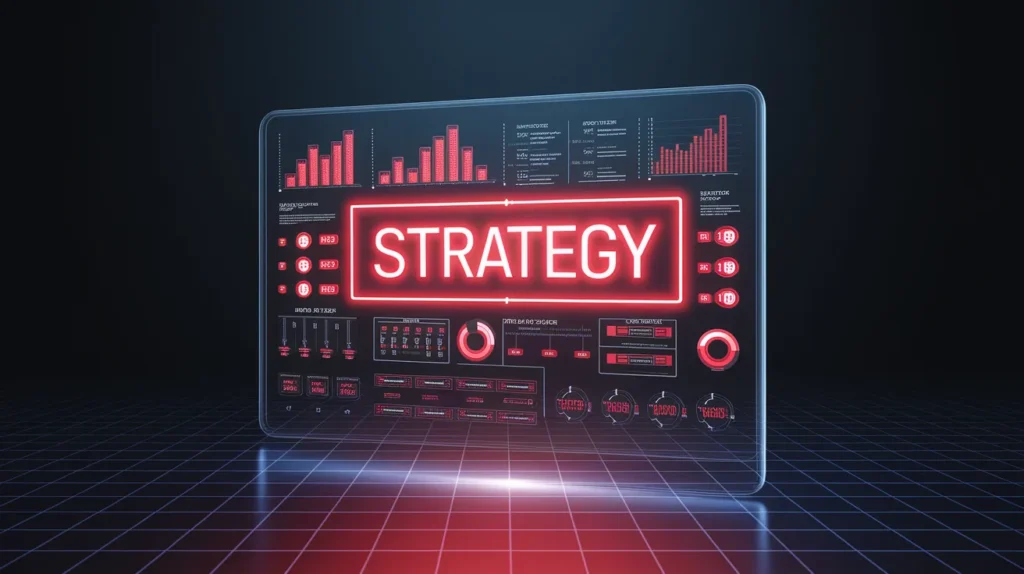Navigating the digital landscape without a map can feel overwhelming. A digital marketing strategy is that map, guiding your online efforts towards clear business objectives. Creating your first strategy involves understanding your goals, identifying your ideal customer, choosing the right online channels, planning valuable content, optimizing your digital assets, and consistently measuring your results to refine your approach. This guide provides a clear, step-by-step process to build a foundational strategy that drives growth.
Why Do You Need a Digital Marketing Strategy?
Jumping into digital marketing tactics without an overarching strategy is like setting sail without a destination. You might be busy, but are you making progress? A well-defined strategy provides:
- Direction and Focus: It aligns your marketing activities with specific business goals.
- Efficiency: It helps allocate resources (time, money, effort) effectively to the channels and tactics that yield the best results.
- Consistency: It ensures your brand messaging and customer experience are coherent across all online touchpoints.
- Measurable Results: It establishes benchmarks and Key Performance Indicators (KPIs) to track progress and demonstrate ROI.
- Competitive Advantage: It allows you to understand the market landscape and carve out your unique position.
As the renowned management consultant Peter Drucker said, “What gets measured gets managed.” A strategy provides the framework for measurement and management.
The Step-by-Step Guide to Your First Strategy

Building your initial digital marketing strategy doesn’t need to be overly complex. Follow these essential steps:
Step 1: Define Your Goals (Make them SMART)
What do you want to achieve with digital marketing? Vague goals like “increase sales” aren’t helpful. Use the SMART framework:
- Specific: Clearly state what you want to achieve (e.g., “Increase qualified leads from organic search”).
- Measurable: How will you track progress? (e.g., “by 20%”).
- Achievable: Is the goal realistic given your resources and timeframe?
- Relevant: Does the goal align with your overall business objectives?
- Time-bound: Set a deadline (e.g., “within the next 6 months”).
Example SMART Goal: “Increase website lead generation through the contact form by 15% in the next quarter (Q3).”
For more on setting effective goals, check out HubSpot’s guide on SMART Goals.
Step 2: Identify Your Target Audience (Create Buyer Personas)
You can’t effectively market to everyone. You need to understand who your ideal customer is. Create detailed Buyer Personas – semi-fictional representations of your ideal customers based on market research and real data. Consider:
- Demographics: Age, location, job title, income level.
- Psychographics: Goals, challenges, pain points, values, interests.
- Online Behavior: Where do they spend time online? What social media platforms do they use? How do they search for information?
- Motivations: What drives their purchasing decisions?
Knowing your audience informs every other aspect of your strategy, from channel selection to content creation.
Step 3: Analyze Your Competition
Understand what your competitors are doing online. Look at:
- Their Website: What’s their messaging? How is their user experience?
- Their Content: What topics do they cover? What formats do they use (blogs, videos, podcasts)?
- Their SEO: What keywords do they seem to be targeting?
- Their Social Media: Which platforms are they active on? What’s their engagement like?
- Their Paid Ads: Are they running Google Ads or social media ads?
Tools like SEMrush or Ahrefs can help, but even manual searching provides valuable insights. Identify their strengths, weaknesses, and potential opportunities for you to differentiate.

Step 4: Choose Your Digital Marketing Channels
Based on your goals, audience, and budget, select the most appropriate digital marketing channels. You don’t need to be everywhere, especially when starting. Focus on where you can make the biggest impact.
| Channel | Description | Best For |
|---|---|---|
| SEO | Optimizing your website to rank higher in search engine results (e.g., Google). | Long-term organic traffic, building authority, lead generation. |
| Content Marketing | Creating and distributing valuable, relevant content to attract an audience. | Building trust, audience engagement, SEO, lead nurturing. |
| Social Media | Engaging with audiences on platforms like Facebook, Instagram, LinkedIn, etc. | Brand awareness, community building, customer service, ads. |
| PPC Advertising | Paying for clicks on platforms like Google Ads or social media. | Quick traffic/leads, targeted campaigns, testing offers. |
| Email Marketing | Building an email list and sending targeted messages. | Nurturing leads, customer retention, direct communication. |
Step 5: Set Your Budget
Determine how much you can realistically allocate to your digital marketing efforts. Consider costs for:
- Tools and software (analytics, SEO tools, email marketing platforms).
- Paid advertising (PPC).
- Content creation (writing, design, video).
- Potentially hiring freelancers or agencies.
Start small, track your spending carefully, and focus on the Return on Investment (ROI) for each channel.
Step 6: Plan Your Content
Content fuels most digital marketing channels. Based on your chosen channels and audience personas, plan the type of content you will create. Consider:
- Blog Posts: Educational articles, guides, industry news.
- Social Media Updates: Engaging posts, questions, behind-the-scenes content.
- Videos: Tutorials, product demos, customer testimonials.
- Infographics: Visually appealing data representations.
- Lead Magnets: Ebooks, checklists, webinars offered in exchange for contact information.
A content calendar can help organize creation and publication schedules.
Step 7: Optimize Your Website & Assets
Your website is often the central hub of your digital presence. Ensure it’s optimized for both users and search engines:
- Mobile-Friendly: It must work flawlessly on all devices.
- Fast Loading Speed: Slow sites frustrate users and hurt SEO rankings. Compressing images is crucial here. Tools like the Free Image Compressor by Neo Core can significantly reduce file sizes without losing quality.
- Clear Navigation: Users should easily find what they need.
- On-Page SEO: Use relevant keywords in titles, headings, and content.
- Clean Code: Well-structured HTML, CSS, and JavaScript contribute to faster loading and better crawlability by search engines. Using a tool to tidy up your code, like the HTML/CSS/JS Minifier & Beautifier by Neo Core, can help streamline your website’s backend for improved performance.

Step 8: Measure and Analyze Results (KPIs)
Digital marketing is highly measurable. Track your Key Performance Indicators (KPIs) regularly to see what’s working and what’s not. Use tools like Google Analytics. Key metrics often include:
- Website Traffic: Overall visitors, traffic sources (organic, social, paid).
- Conversion Rate: Percentage of visitors completing a desired action (e.g., filling a form, making a purchase).
- Cost Per Lead (CPL) / Cost Per Acquisition (CPA): How much it costs to gain a lead or customer.
- Engagement Rate: Likes, shares, comments on social media.
- Search Engine Rankings: Your position for target keywords.
Use this data to refine your strategy, double down on successful tactics, and adjust or eliminate underperforming ones.
Putting It All Together: Your Strategy Document

Compile your findings and decisions into a simple document. It should summarize:
- Your SMART Goals
- Your Buyer Personas
- Your Competitive Overview
- Your Chosen Channels & Tactics
- Your Budget Allocation
- Your Content Plan Outline
- Your Key Performance Indicators (KPIs)
This document serves as your roadmap and reference point.
Tools to Help You Along the Way
While strategy is key, certain tools can streamline execution. As mentioned, optimizing website assets is vital. Ensuring your images are web-ready with an Image Compressor and that your website code is clean using an HTML/CSS/JS Minifier/Beautifier are foundational steps available for free at Neo Core. Furthermore, if your strategy involves bridging offline and online experiences (e.g., linking a print ad or event signage to a specific landing page), a Custom QR Code Generator like the one offered by TheNeoCore can be a simple yet effective tool.
Conclusion: Start Building Your Digital Future
Creating your first digital marketing strategy sets the foundation for sustainable online growth. It transforms random actions into purposeful steps towards achieving your business objectives. By defining your goals, understanding your audience, choosing the right channels, planning valuable content, optimizing your assets, and consistently measuring your results, you move from guessing to growing. Don’t aim for perfection initially; aim for progress. Start with this framework, implement, learn, and refine. Your digital future awaits!

